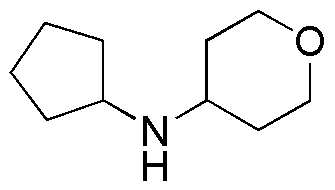Cyclopentyl-(tetrahydropyran-4-yl)amine is widely utilized in research focused on:
- Pharmaceutical Development: This compound serves as a key intermediate in the synthesis of novel pharmaceuticals, particularly in the development of drugs targeting central nervous system disorders.
- Neurotransmitter Research: It is used in studies investigating neurotransmitter systems, helping researchers understand mechanisms of action for various neurological conditions.
- Organic Synthesis: The compound is valuable in organic chemistry for creating complex molecular structures, enhancing the efficiency of synthetic pathways compared to traditional methods.
- Material Science: Its unique properties make it suitable for developing advanced materials, including polymers that exhibit improved mechanical and thermal stability.
- Biochemical Applications: Researchers utilize it in biochemical assays to explore enzyme interactions and metabolic pathways, providing insights into cellular processes.
General Information
Properties
Safety and Regulations
Applications
Cyclopentyl-(tetrahydropyran-4-yl)amine is widely utilized in research focused on:
- Pharmaceutical Development: This compound serves as a key intermediate in the synthesis of novel pharmaceuticals, particularly in the development of drugs targeting central nervous system disorders.
- Neurotransmitter Research: It is used in studies investigating neurotransmitter systems, helping researchers understand mechanisms of action for various neurological conditions.
- Organic Synthesis: The compound is valuable in organic chemistry for creating complex molecular structures, enhancing the efficiency of synthetic pathways compared to traditional methods.
- Material Science: Its unique properties make it suitable for developing advanced materials, including polymers that exhibit improved mechanical and thermal stability.
- Biochemical Applications: Researchers utilize it in biochemical assays to explore enzyme interactions and metabolic pathways, providing insights into cellular processes.
Documents
Safety Data Sheets (SDS)
The SDS provides comprehensive safety information on handling, storage, and disposal of the product.
Product Specification (PS)
The PS provides a comprehensive breakdown of the product’s properties, including chemical composition, physical state, purity, and storage requirements. It also details acceptable quality ranges and the product's intended applications.
Certificates of Analysis (COA)
Search for Certificates of Analysis (COA) by entering the products Lot Number. Lot and Batch Numbers can be found on a product’s label following the words ‘Lot’ or ‘Batch’.
*Catalog Number
*Lot Number
Certificates Of Origin (COO)
This COO confirms the country where the product was manufactured, and also details the materials and components used in it and whether it is derived from natural, synthetic, or other specific sources. This certificate may be required for customs, trade, and regulatory compliance.
*Catalog Number
*Lot Number
Safety Data Sheets (SDS)
The SDS provides comprehensive safety information on handling, storage, and disposal of the product.
DownloadProduct Specification (PS)
The PS provides a comprehensive breakdown of the product’s properties, including chemical composition, physical state, purity, and storage requirements. It also details acceptable quality ranges and the product's intended applications.
DownloadCertificates of Analysis (COA)
Search for Certificates of Analysis (COA) by entering the products Lot Number. Lot and Batch Numbers can be found on a product’s label following the words ‘Lot’ or ‘Batch’.
*Catalog Number
*Lot Number
Certificates Of Origin (COO)
This COO confirms the country where the product was manufactured, and also details the materials and components used in it and whether it is derived from natural, synthetic, or other specific sources. This certificate may be required for customs, trade, and regulatory compliance.


